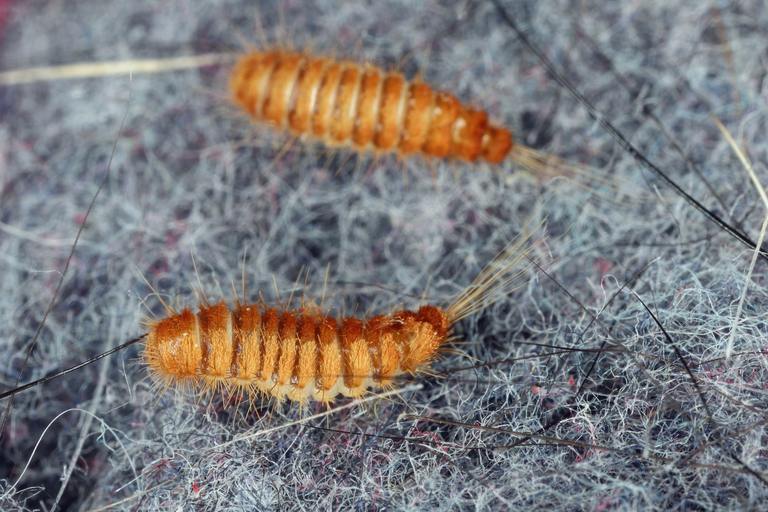How to Get Rid of Carpet Beetle Larva in Your Home
Published: September 23, 2024

Carpet beetles, though small and seemingly harmless, can become a significant nuisance if left unchecked. Their larvae, in particular, are known for causing damage to household items such as carpets, clothing, and upholstery. In this article, we will delve into what carpet beetles are, how their larvae infiltrate homes and proliferate, the potential dangers they pose to homeowners and their pets, and effective DIY treatment methods. Additionally, we will underscore the importance of seeking professional pest control services for comprehensive management.
Understanding Carpet Beetles
Carpet beetles belong to the family Dermestidae and are small insects that come in various colors ranging from black to spotted patterns. The three most common species found in homes are the varied carpet beetle (Anthrenus verbasci), the black carpet beetle (Attagenus unicolor), and the furniture carpet beetle (Anthrenus flavipes). While adult carpet beetles primarily feed on pollen and nectar outdoors, it is their larvae that cause problems indoors.
How Carpet Beetle Larvae Enter Homes
Carpet beetle larvae can enter homes through several means:
- Open Windows and Doors: Adult carpet beetles often fly into homes through open windows or doors.
- Infested Items: Second-hand furniture, clothing, or other infested items brought into the home can introduce larvae.
- Animal Entrances: Pet fur or bird nests near windowsills can be carriers for these pests.
- Cracks and Crevices: Small openings around windowsills or door frames provide easy access for adult beetles to lay eggs inside your home.
Once inside, female carpet beetles lay eggs on materials like woolen fabrics, carpets made from natural fibers, leather goods, and even dried plant products. The larvae then hatch and begin feeding voraciously on these organic materials.
Dangers of Carpet Beetle Infestations
While carpet beetles do not pose direct health risks like some other pests do (e.g., cockroaches), they still present several concerns:
- Damage to Property: The primary issue with carpet beetle larvae is their diet; they consume natural fibers which can result in damage to clothes, carpets, upholstered furniture, blankets, etc.
- Allergic Reactions: Some individuals may develop allergic reactions such as dermatitis upon contact with larval hairs or shed skins.
- Pet Safety: Pets may also experience discomfort if they come into contact with larval hairs. Moreover, ingestion of contaminated materials could lead to digestive issues.

DIY Treatment Methods
If you suspect a minor infestation of carpet beetle larvae in your home, there are several steps you can take before calling in professionals:
Thorough Cleaning
- Vacuum Regularly: Vacuum all carpets thoroughly including under furniture where larvae might hide. Use attachments for upholstery cleaning.
- Wash Fabrics: Launder all affected clothing items at high temperatures (above 120°F) which kills both eggs and larvae.
- Steam Cleaning: For non-washable items like curtains or heavy drapes consider steam cleaning them.
Preventive Measures
- Seal Entry Points: Inspect your home’s exterior walls carefully sealing any cracks/crevices found using caulk/sealant products available at hardware stores.
- Store Items Properly: Keep susceptible items stored properly – use airtight containers/bags especially when storing seasonal clothing/blankets/rugs etc., away until needed again next year!
Importance of Professional Pest Control
While DIY methods may help mitigate minor infestations temporarily – professional pest control services provide lasting solutions ensuring complete eradication & prevention measures tailored specifically towards individual needs!
Professionals employ advanced techniques/tools inaccessible otherwise making sure no stone remains unturned during inspection/treatment stages alike! They also educate clients about preventive practices reducing chances future re-infestations occurring again down line thus offering peace mind knowing problem dealt effectively once all!
Conclusion
Carpet beetle infestations can lead not only property damage but also potential health risks affecting both humans/pets within households alike! While some initial steps taken yourself help manage situation short term basis – ultimately enlisting expert assistance ensures thorough resolution safeguarding home environment long-term basis! Always remember prevention better cure so stay vigilant keep surroundings clean organized minimizing chances unwanted guests settling anytime soon!